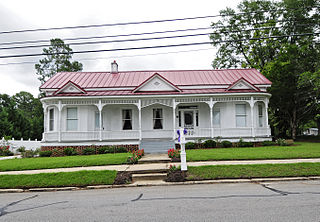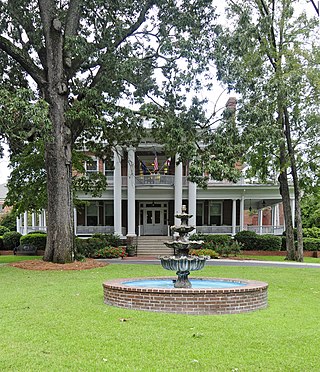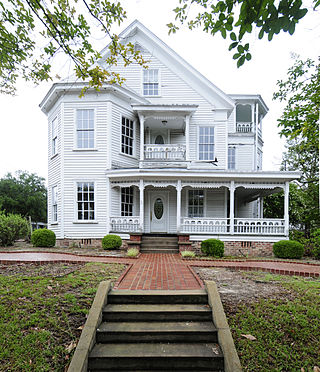James Stewart House, also known as Stewart's Corner, is a historic home formerly located in Lexington, Lexington County, South Carolina. It was built in 1850, and is a 1 1/2-half story, rectangular, frame cottage with a gable roof and two interior chimneys. It features a porch with a high gable supported by square wood posts. To avoid demolition, the house was moved about 1991 from its original location on West Main Street in Lexington to its current site in the vicinity of Red Bank, South Carolina.

Simon Bouknight House is a historic home located at Batesburg-Leesville, Lexington County, South Carolina. It was built in 1890, and is a one-story, weatherboarded Victorian cottage under a gabled roof. It has a gabled projecting central porch supported by four regularly spaced slender wood posts; front and end gables with cornice returns and centered, diamond-shaped windows; and corbeled chimneys. The house is set on a lattice brick foundation.

Cartledge House is a historic home located at Batesburg-Leesville, Lexington County, South Carolina. It was built about 1898, and is a two-story, Victorian-era weatherboard dwelling. It consists of a rectangular central block under a hipped roof with sheet metal shingles and a truncated ridge. Double gallery porches wrap around the front and side elevations on both stories ornamented by Tuscan order colonettes and turned balustrades. The front roof slope features a steep cross gable pierced by a circular vent.

Thomas Galbraith Herbert House, also known as the Shealy House, is a historic home located at Batesburg-Leesville, Lexington County, South Carolina. It was built in 1878, and is a 1 1/2-half story Victorian Eclectic style dwelling. It is sheathed in weatherboard and has a raised seam, metal, multi-gabled roof. It features a projecting front gable with a recessed balcony and a full width front porch.

J. B. Holman House is a historic home located at Batesburg-Leesville, Lexington County, South Carolina. It was built in 1910, and is an asymmetrical, two-story Queen Anne style frame residence. It features a polygonal, tent roofed turret and wraparound porch. The hipped porch is supported by paired Tuscan order colonettes. The gabled roof is sheet metal shingles and the house is sheathed in aluminum siding.

A. C. Jones House is a historic home located at Batesburg-Leesville, Lexington County, South Carolina. It was built in 1904, and is a California bungalow form influenced weatherboard residence. The hipped roof has three large, hipped dormers. The dormers, roof, and projecting wraparound porch have exposed rafters. The house and porch sit on a granite foundation.

John Jacob Rawl House is a historic home located at Batesburg-Leesville, Lexington County, South Carolina. It was built about 1900, and is a one-story frame Victorian dwelling with elaborate carpenter's ornamentation. It has a brick pier foundation and a standing seam metal gable roof. The façade features a porch with rounded corners and an elaborate spindle frieze.

Still Hopes, also known as the Gabriel Alexander Guignard House and South Carolina Episcopal Home, is an historic home located in West Columbia, South Carolina, Lexington County, South Carolina. It was built in 1910, and is a two-story, brick, Georgian Revival mansion with a truncated hip roof. The front façade features a two-story, flat roofed portico supported by paired Ionic order columns. It has a one-story, ornamented wraparound porch. In 1977, it was expanded and renovated to convert the mansion and new structure for use as an Episcopal retirement community. It was built as a residence for Gabriel Alexander Guignard (1860-1926), and the red brick for construction was manufactured by Guignard Brick Works.
David Jefferson Griffith House is a historic home located near Gilbert, Lexington County, South Carolina. It was built in 1896, and is a rectangular, two-story frame, weatherboarded Late Victorian farmhouse with a standing seam metal hipped roof. It has a one-story, gable-roofed ell. The front façade features a two-tiered decorated porch. Also on the property is a hip-roofed well house.

The Jacob Wingard Dreher House, also known as Glencoe Farm, is an historic home located near Irmo, Lexington County, South Carolina. It was built about 1830–50, and is a two-story, rectangular weatherboarded frame farmhouse. It has a gable roof and features a one-story, shed-roofed porch across the front façade. A single story wing, added about 1910, is connected to the left elevation by a porch. Also on the property is a one-story, frame, weatherboarded store building, which was moved to its present location about 1945.

Ballentine-Shealy House, also known as the Ballentine-Shealy-Slocum House, is a historic home located near Lexington, Lexington County, South Carolina. It was built in the late-18th or early-19th century, and is a 1+1⁄2-story, rectangular log building. It is sheathed in weatherboard and has a standing seam metal gable roof. It has shed rooms on the rear and a one-story shed-roofed front porch with an enclosed room. The house has a hall-and-parlor plan and an enclosed stair. An open breezeway connects the house to the kitchen, which has a fieldstone and brick chimney and a side porch. Also on the property a dilapidated dairy, a small log barn, and a well house.

W. Q. M. Berly House is a historic home located at Lexington, Lexington County, South Carolina. It was built in 1904, and is a one-story, frame cottage with a gable roof and irregular plan. It features a cross gable with sawn bargeboard, and a hip-roofed wraparound porch.

William Berly House is a historic home located at Lexington, Lexington County, South Carolina. It was built by 1832, and is a two-story, clapboard dwelling. It features a one-story porch supported by four square columns. The house originally was in the dogtrot form. It has a one-story wing attached to the main house by an enclosed breezeways around 1900. Also on the property is a contributing former ice house. It was the home of Reverend William Berly, a leading religious and educational figure in area Lutheranism during the mid-19th century.

John Solomon Hendrix House, also known as the Sol Hendrix House, is a historic home located near Lexington, Lexington County, South Carolina. It was built about 1850, and is a two-story, rectangular, weatherboarded frame farmhouse. It has a gable roof and exterior end chimneys. The front façade features a double tiered porch supported by square wood posts.
John Jacob Hite Farm, also known as the Jason Hite Place, is a historic home and farm located near Lexington, Lexington County, South Carolina. It was built about 1870 and is a one-story, frame cottage with weatherboard siding and a gable roof. The house features an enclosed front roof on the left and a porch on the right. The farm complex includes a corncrib, two log barns, and one frame barn.
Henry Lybrand Farm, also known as the Connelly Farm, is a historic home and farm located near Lexington, Lexington County, South Carolina. It was built about 1835, and is a two-story, rectangular, frame dwelling. It is sheathed in weatherboard and has a gable roof. The front façade features a one-story shed-roofed porch supported by square wood posts. The house has a one-story rear ell, built about 1900. Also on the property is the only intact cotton gin house left in the county, a cook's house, a small wash house, a smokehouse, a log barn, a two-story log barn, a corncrib, and a granary.

Gunter-Summers House, also known as the Henry Jacob Summers House, is a historic home located at West Columbia, Lexington County, South Carolina. It was built in 1895, and is an I-house with Queen Anne style decorative elements with an Eastlake theme, notably the geometric banded frieze and geometric stained glass doors with running trim. It is a two-story, frame dwelling and has weatherboard siding and a brick pier foundation. The front façade features a two-tiered, full-width front porch. Also on the property are a barn and a smokehouse with a braced overhanging front gable.

Charlton Rauch House is a historic home located at Lexington, Lexington County, South Carolina. It was built in 1886, and is a 2+1⁄2-story, frame vernacular Queen Anne style house with an irregular plan and a gable roof. It is sheathed in weatherboard and has a one-story rear wing. the front façade features a one-story, hip roofed porch with a second-story, shed-roofed porch; a two-story polygonal bay; and a hip-roofed, three-story, projecting polygonal bay. Its owner Charlton Rauch operated a livery stable and was a cotton buyer and dealer in general merchandise.
Vastine Wessinger House is a historic home located near Lexington, Lexington County, South Carolina. It was built about 1891, and is a two-story, rectangular, frame farmhouse. It is sheathed in weatherboard and has a truncated hip roof. The front façade features a projecting Victorian influenced, ornamented double-tiered porch. Also on the property is a contributing small, frame building used as a garage, but originally operated as a store by in the 1890s and from 1910 to 1935 as a farm commissary.

Marsh-Johnson House, also known as Robert Johnson House, is a historic home located near Saluda, Saluda County, South Carolina. It was built about 1817, and is a two-story, log farmhouse sheathed in weatherboard. The house sits on a brick foundation and has a one-story, shed-roofed porch. It is considered one of the earliest and intact log residences in South Carolina. The house rests on massive brick piers, which are laid in Flemish bond. A one-story, shed-roofed porch with wooden foundation piers and four rough hewn tree trunks supporting the roof spans the façade. Many of the windows retain their batten shutters.



















